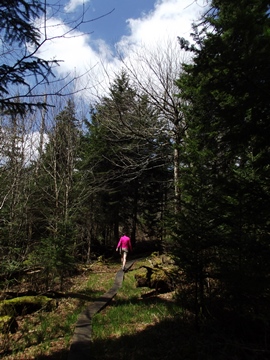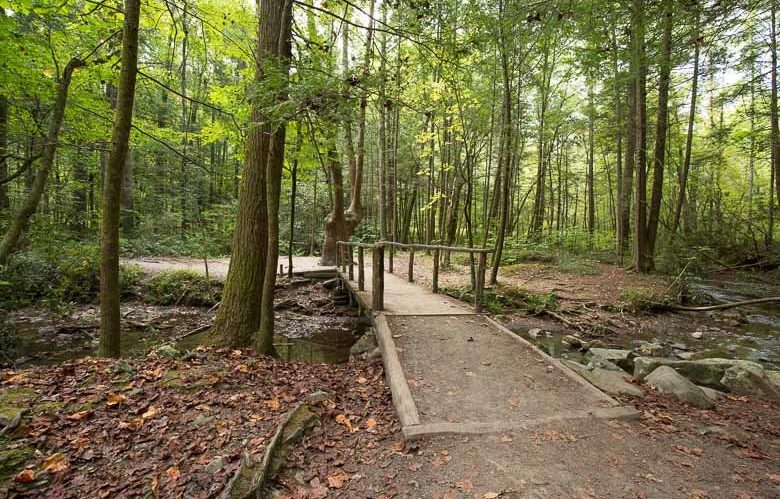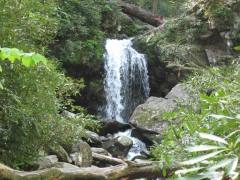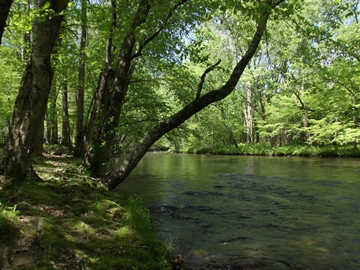
Great Smoky Mountains National Park offers some of the best hiking in the U.S., and with more than 800 miles of trails, you can rest assured this most-visited national park in the country has a little something for everybody. That includes no shortage of easy hikes that sample the beauty, grandeur, and ecological diversity of this transfixing Southern Appalachian realm.
The following 10 hikes are all on the low end of the difficulty spectrum, and most are very short. For Smoky Mountain visitors strapped for time or less inclined to tackle challenging treks, these are all top-notch options!
Laurel Falls

Among the most popular paths in the park, the 2.7-mile round-trip Laurel Falls Trail leads to a spectacular 80-foot, double-decker waterfall on Laurel Branch. The trail’s fully paved, but be aware it’s uneven in spots, so watch your footing—and certainly keep watching it around the falls themselves. A footbridge extends over the Laurel Branch between the two levels of Laurel Falls for a pretty darn unforgettable turnaround point. Time your stroll for May, and you’ll likely get to enjoy the spectacular blooms of the mountain laurels that give the creek and its gorgeous plunge their name.
Gatlinburg Trail
One of only two trails in the park to allow both bicycles and dogs, the Gatlinburg Trail links the outskirts of Gatlinburg, Tennessee and the Sugarlands Visitor Center, providing a unique and laidback means of walking between the national park and one of its best-known gateway towns. This 3.8-mile (round-trip) gravel trail shadows the West Prong of the Little River for a pleasant, easy-to-reach ramble.
Clingmans Dome

The half-mile paved walk from the parking area to the observation tower atop 6,643-foot Clingmans Dome is, admittedly, on the steeper side of things—the trail gains some 332 feet—but its short distance and the availability of benches for taking a breather or two earn its spot on this list. Plus, the reward’s a big-time one: You’ll get to stand at the crown of the highest peak in the Great Smokies (and the third-highest in the eastern U.S.), with roof-of-the-world sightlines on a clear day extending more than 100 miles. Hoof it up to Clingmans Dome in October, furthermore, and you’ll get to enjoy one of the best “leaf-peeping” vantages in the Southeast.
Cove Hardwoods Nature Trail
Accessed from the Chimney Tops Picnic Area, this 0.9-mile (round-trip) self-guided interpretive trail shows off the magnificence of perhaps the most impressive vegetation zone in the Southern Appalachians: the incredibly diverse, cathedral-like cove hardwood forest. This path winds through a fine example of this community at the foot of Sugarland Mountain, with a significant share of old-growth trees—from eastern hemlocks, yellow birches, sugar maples, and yellow buckeyes to basswoods, tulip trees, and Carolina silverbells. In spring, the Cove Hardwoods Nature Trail puts on a knockout display of wildflowers, including trilliums, fringed phacelias, spring beauties, and rue anemones.
Spruce Fir Nature Trail

This is an even shorter nature trail (a mere 0.35 miles round-trip) through a completely different Smoky Mountain forest zone: the high woods of Fraser fir (“she-balsam”) and red spruce (“he-balsam”) that darken ridge crests and summits throughout the Southern Appalachians. Level for the most part, with boardwalk sections, the Spruce Fir Nature Trail along the road to Clingmans Dome gives you a magical taste of the quiet, shady, vaguely mysterious vibe of these high-elevation forests.
Sugarlands Valley Nature Trail
Another interpretive path, the Sugarlands Valley Nature Trail is a half-mile loop heading at the Sugarlands Visitor Center that, given its level pavement, is suitable for wheelchairs and baby strollers. The pretty woods and creekside on display here are serene, and you’ll also spy some stone walls, crumbling chimneys, and other remnants of early Euro-American Smoky Mountain settlement.
Fighting Creek Nature Trail

Here’s another short, easy, fascinating interpretive path kicking off at the Sugarlands Visitor Center. The 1.2-mile loop of the Fighting Creek Nature Trail reveals remnants of the historic Forks of the River settlement; its midway point comes at the restored, circa-1860 John Ownby Cabin, which you can actually walk inside. It’s also easy to tack on a little detour by following a spur off the nature trail to the Cove Mountain Trail and taking that a short way to Cataract Falls.
Grotto Falls

The Great Smokies boast a surplus of beautiful waterfalls, and Grotto Falls is one of the most notable: not only for its postcard-perfect plunge into an alcoved pool but also on account you can actually walk behind the curtain of water. It’s an easy 2.6-mile round-trip forest hike to the waterfall off the Roaring Fork Motor Nature Trail via the Trillium Gap Trail (which continues on past Grotto Falls to eventually summit Mount LeConte).
Little River Trail

Heading near Elkmont Campground, the Little River Trail is another easy, family-friendly option offering a lovely streamside atmosphere. It traces a historic track used by the Little River Lumber Co. in the early 20th century, and evidence of bygone logging is plain to see in the second-growth woods. Highlights include Huskey Branch Falls (only one of a number of whitewater features along this cascade-ridden drainage) and, in spring, outstanding wildflower displays. Those looking for a fairly short hike typically turn back at the junction with the Cucumber Gap Trail, which makes for a 4.9-mile round-trip walkabout.
Oconaluftee River Trail

The southern analogue to the Gatlinburg Trail, the Oconaluftee River Trail also links a Great Smoky Mountains National Park visitor center—in this case, the Oconaluftee Visitor Center—with a gateway community: Cherokee, North Carolina. Plus, it’s the only other trail besides the Gatlinburg allowing pooches and bicycles. An easy round-trip walk of three miles, the trail takes you through some fetching riverside woods and serves up nuggets about indigenous Cherokee culture and traditional lifeways via informational signs along the route. A walk on the Oconaluftee River Trail’s also rewarding to combine with a stroll through the intriguing Mountain Farm Museum at the visitor center.